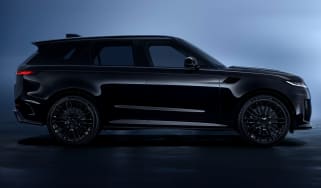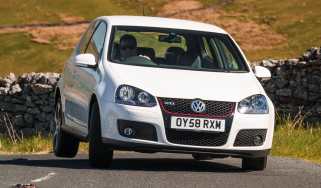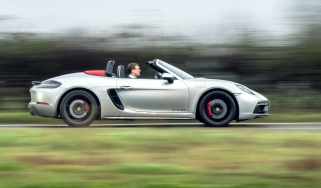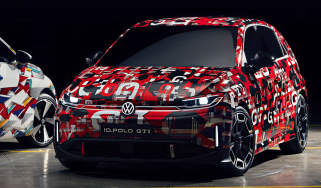Bowler EXR S v Porsche Cayenne GTS v Nissan GT-R
The 550bhp, £186,000 Bowler is described by its makers as an ‘all-terrain supercar’. We find out if it lives up to its billing – and pitch it against the Porsche Cayenne GTS and Nissan GT-R
Flummoxed. That’s what I am at the moment. I’m on a wave of euphoria, smiling from sideburn to sideburn and shaking slightly after driving the Bowler EXR S, but I’m also more lost than a Dakar driver in Africa as to how to define it. And my colleague Jethro Bovingdon isn’t any help either; ‘I’m bloody glad you’re the one writing this,’ is all he can say when he clambers out from amongst the orange tubing and pats me on the shoulder comfortingly a little while later. This car is utterly unique and all I know is that if my six numbers came up then I’d absolutely definitely want one. But what for?
‘We call it an all-terrain supercar,’ offers Jon Chester from Bowler. And that’s certainly as good a description and excuse for wanting one as any I can think of at the moment.
Let’s start at the beginning. Bowler, based in Derbyshire, designs and builds vehicles to compete in rally raids and has been doing so since 1983. In the past we’ve had the Wildcat and the Nemesis, and currently there is the even more capable but slightly less imaginatively named EXR (without the S. We’ll come to that in a minute). They are capable of crossing pretty much anything you put in their way at astonishing speed and, despite first appearances, none of them started out in life as a Land or Range Rover. Yes, the engines can be found in the off-roaders from Coventry and you might be able to swap a steering wheel or wing mirror, but Bowler doesn’t chip away at a standard road car to find the race car underneath. No, the hydroformed chassis and steel roll-cage of the EXR are unique and are covered in composite panels that merely happen to cleverly ape the shapes of a Range Rover, while at the same time coercing the air to flow where it is needed and allowing monster articulation in the wheelarches.
Now, that S. Bowler was quite happy just producing race cars, but some of its customers had other ideas and decided that they would like a road-going version of their race car. Something that they could take to Tesco (all right, more likely Waitrose) or pop down to Paris for the weekend in, without feeling the need to carry on to Senegal. And so, through sheer customer demand, the EXR S was born.
The ‘S’ is for supercharged, because without the need to conform to FIA regulations the road car gets the full-fat 550bhp, 461lb ft supercharged 5-litre V8 compared to the race car’s naturally aspirated 300bhp, 429lb ft version. There is also no requirement for a full FIA roll-cage in the road car although this car’s owner has requested one nonetheless, along with full race bucket seats and harnesses. Other customers have specified slightly plusher leather seats, three-point belts and satnav. In the back you would normally find a 385-litre fuel cell, but without the need to do laps of the UK the EXR S now has a useful-looking load bay (probably making this the first supercar you could put a bike in). Bowler is also currently developing a two-plus-two version in case people want to use one for the school run.
Open the bonnet and you initially wonder where the engine has gone, until you spot it hiding at the back of the bay under the windscreen. The V8’s front-mid-mounted position is almost more obvious when you climb up into either of the seats and spy its encroachment into the footwells. The suspension has been changed from competition-spec Donerre dampers (which are still an option) to more road-biased Bilsteins, which almost look like double-spring units when you first stick your head under the arches and see the enormous reservoirs. Once again, freed from pesky regulations, the Eibach springs have more travel than the race car’s units – up 32mm to a whopping 282mm. Hanging off the end of these are 22in wheels, which sound horrifically rapper but don’t look in the slightest bit out of place, such is the voluminous size of the arches they sit in. Tyres are road-spec Coopers.
The view out might be about three feet higher than in an Enzo or Huayra, but the EXR S has definitely got that intimidating theatre of a supercar when you’re sitting in it. There’s plenty of beautiful carbonfibre too. Start the V8 via the button on the transmission tunnel and the big, empty interior fills with a deep, industrial roar, ramping up the supercar quotient a little further. When you set off down the road, however, it’s almost disarmingly easy to drive initially, because the standard six-speed Range Rover automatic means you have nothing more difficult to do than press the throttle. The power-assisted steering is light and easy to twirl too, so despite the Bowler’s butch appearance you don’t have to be a Hercules to potter around town. And although it does feel wide, sleeping policemen have never felt so insignificant.
Urban manoeuvring is where the sanity begins and ends though, because as soon as you hit a national speed limit sign the performance becomes as wild as the car looks. Nail the throttle, the nose lifts, the engine roars and you charge at the horizon in a way that leaves you utterly flabbergasted. The EXR S has a claimed 0-62mph time of just 4.2 seconds. That, I know, probably sounds about as fantastical as a hippo being able to run faster than Usain Bolt, but both are absolutely true. And then there are the corners…
I think it is fair to say that most people would be fairly shocked, possibly even alarmed, if they jumped into an EXR S and tried to drive it quickly through a set of bends. I was lucky enough to drive a Wildcat a few years ago, so had an inkling of what to expect, but even so it takes me quite a while to start getting my head around the utterly bonkers EXR S, and after my first fast run I find I’m shaking with what I suspect is a mixture of adrenalin and mild terror. I tell Bovingdon it’s just the cold and blow into my hands by way of confirmation. I don’t think he buys it. And to be fair, he admits to feeling completely at sea in the corners during the few miles he drives in the car and expresses a wish for somewhere with a smidge of run-off (like the Russian Steppe) to get to know it.
What makes the Bowler so alien to drive is the vast amount of suspension travel in the relatively short and square wheelbase. For a start it makes everything feel slightly aloof and soft as the car rolls and pitches more than you’re used to. Secondly, if you try to drive it ‘normally’ then you’ll simply get a lot of understeer. Turn in quickly and you get understeer. Get on the power aggressively on the way out of a corner and you’ll get understeer. It feels about as vague yet crazy as a monster truck, or a rally car on gravel settings…
And therein lies the key; if you’re going to get the best from a Bowler, if you’re going to really enjoy it, then you need to drive it like you would a car on gravel. This means being confident and positive, getting the car set up early for a corner, trail braking, even backing it in a touch (something helped by a lot of rear brake bias on this car) so that you oversteer slightly before the apex and then drive through using the huge traction of the four-wheel drive (split 50:50). It sounds daft but it’s honestly the way it wants to be driven if you want to travel quickly.
The trouble is that this isn’t an easy way to drive, especially when you’ve got 1800kg of metal moving around underneath you. And you can’t realistically drive like this on the road any more than you can drift an M5 round every corner, so we’ve come to a beautiful private test track not far from Bowler’s HQ. Unfortunately it’s also a tightly twisting private test track with stone walls, random boulders and a man-made lake seemingly never more than a few perilous feet away and at times I wonder if it wouldn’t have been less dangerous to stay on the wintry roads of Derbyshire. At least I know there won’t be anything coming the other way out of the blinding low winter sun.
Curiously you need to be both quite cajoling to get the EXR S moving, yet quite subtle when judging and managing the grip, balance and weight transfer. It’s a tricky knack to master if your birth certificate doesn’t read C. Sainz, but it’s also hugely rewarding and fun when you get it right on the occasional corner. The other thing you need to do is think a long way ahead. To that extent, Drew Bowler (a very quiet but extraordinarily nice man) likens it to driving a speedboat, because what you do now will likely be having implications some way down the line. By the same token, if you get it wrong then you need to have a lot of space to gather it all up because the towering suspension travel combined with serious momentum means that the EXR S doesn’t react to inputs in the blink of an eye. If only there were a lot of space here.
After a while I think I’ve managed to tone everything down a few notches and get the Bowler to flow through corners in a slightly neater and less extrovert way that will work on the road, but it feels like you almost need to go big on a track and then knock it back to reach this stage. Curious.And now the rivals...
When we were back the evo office (it’s like the Batcave, but with fewer weapons and more coffee. Actually the Bowler would make rather a good car for cruising Gotham…) planning this feature we thought it would be an excellent idea to pitch a couple of cars against the Bowler to try and give it some context. So, first we’ve brought along what you might call a conventional fast 4x4, the Cayenne GTS, which is the most dynamically focused version of Porsche’s SUV. Second we’ve brought along a GT-R. Such are the talents of the big Nissan that it seems to slot seamlessly into almost any group test that we might care to devise, and with four-wheel drive, 542bhp, 466lb ft and a kerb weight of 1740kg, it’s too close on paper to the Bowler to be ignored.
But what look like excellent comparisons on a sheet of Xerox can suddenly seem very wide of the mark when you park them up in the real world. Having now driven the Bowler EXR S I know that neither of the other cars we’ve brought along is really in the same ballpark. They’re extraordinary in their own right but way too conventional in this company. The Cayenne feels like a go-kart after the Bowler. That really isn’t an exaggeration either. Its barrage of air-suspension, PASM, torque vectoring and self-levelling PDCC all mean that it seems to corner completely flat and change direction like some sort of Mitsubishi Evo on steroids. It’s quite impressive and I have to say that I love it. It jinks into corners and when you pick up the throttle you instantly feel the rear axle start to steer the GTS round. Above 4000rpm the naturally aspirated 414bhp 4.8-litre V8 sounds really, really good too, with a surprisingly loud and mellifluous gargle.
Start up the GT-R and it sounds more industrial and mechanically raw than the race-bred EXR S, which is surprising. At low speeds the Nissan’s twin-clutch gearbox clunks and thumps as it engages ratios, and the tightly wound diffs mean its wheels seem to claw at the surface of the road just like a barely concealed race car. It feels faster than the Bowler in a straight line, but not by much, and some of the deficit is down to the masking effect of the squat in the EXR S’s suspension as it accelerates off the line.
What the GT-R and Cayenne both undoubtedly have are better gearboxes than the Bowler. The six-speed auto might make the EXR S easy to drive around town, but it seems slightly obstructive to swift progress when you’re grappling with slides and corners (sadly the racer’s six-speed Sadev sequential ’box can’t be used as it can’t cope with the supercharged engine’s larger torque output). If I was being picky I’d actually like bigger paddles not attached to the steering wheel, as the Bowler requires quite a lot of lock in tighter corners and you can find yourself hunting for the correct paddle. The brilliant ZF eight-speed auto from the new Range Rover (as well as Bentleys and plenty of others) might be a good option, or you could do as one customer has and request a manual…
Of course, what the GT-R can’t do is turn off the road, climb the verge, head through a gateway and take a shortcut across a quarry or through a forest. The Cayenne GTS could, but not in the carefree and blisteringly quick way that the EXR S can. It certainly couldn’t fly off a lip like the one on the first page of this feature and survive. While the Bowler feels soft on road, it actually feels quite firm off road on its Bilsteins, but without changing the 22-inch wheels or the very un-knobbly tyres, the Bowler tackles the off-road course (conveniently over the hill from the tarmac track) with ease and pace. Yes, it’s struggling for grip in the deepest sand and mud but it’s on road tyres, and despite its firmness it tracks the ground very well over the bumpier, rockier sections. It feels much more balanced under power too. If we’re honest this is where it feels at home.
The jump looks big enough to beach the Cayenne if it tried to even roll over it and launching nearly two tons of metal off it at speed on as-yet-untried dampers seems faintly stupid. I ask Drew Bowler if he wants to drive for the jump shot as he’s got much more experience (and it’s his car if it breaks!), but with a big grin he says he’s given up doing that sort of thing these days and it’s all mine…
I build up to it at first, but eventually I get decent, if slightly oversteery, traction out of the long muddy corner before and we fly off the ramp with more conviction. The landing’s heavy, very heavy, particularly at the rear, and it’s obvious that the EXR S would benefit from the set of hydraulic bump stops that Drew says will be added, but both the car and my spine are intact. What’s more, we survive another three or four goes too, only just managing to brake before the trees and a sharp right turn each time. By the end, though, I’m not sure I wouldn’t go the whole hog and spec the all-singing Donerre dampers if I had one, just so that I could be absolutely certain of crushing everything in my path. It might sacrifice a touch more on-road ability (and I’m sure some might want to go more in the direction of the road-focused Porsche instead) but I think it would be childishly worth it just to be able to get another few feet of air under the wheels.
As you might have gathered, I like the Bowler EXR S. A lot. It’s not a substitute for a traditional supercar in a dream garage in any way (or a GT-R or a Cayenne GTS for that matter), and Bowler is refreshingly realistic enough to say that it sees this as a fifth or sixth car in someone’s fleet. But nevertheless it does put a big tick in an awful lot of supercar boxes. There’s the outlandish looks and pure showmanship of it for a start. As Jethro commented, ‘How cool would it be to rock up to a smart London hotel in one of these covered in mud?’ Then there’s the blood-and-thunder soundtrack, which probably woke up anything hibernating within a 50-mile radius in Derbyshire and matches the brawny stance of the EXR S so perfectly.
The £186k price tag is sadly also suitably junior supercar. And finally there’s the driving experience, which is made up of shocking straight-line performance and a cornering attitude that feels as high stakes as any hyperactive, twitchy ‘ordinary’ supercar you care to name. In short it is utterly unlike anything else you are likely to drive, which is reason enough to secure it a place in your fantasy garage. However, I have also worked out the precise occasion and purpose that I’d want one for: come the apocalypse, it’s the car I’d pick for trying to outrun the chaos.






